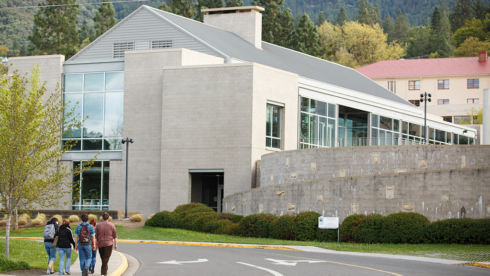
The once defiant students positioned in the front rows of the HECC meeting on May 11 appeared visibly deflated as another tuition increase greater than 5 percent was approved. Recently elected ASSOU president Daryl Maplethorpe was one of the students opposing the tuition hikes. “I felt like I had failed,” she admitted, eyes cast down and voice tired, shortly after the decision. Recalling this moment, her eyes steeled as she realized the amount of work in the year ahead because “there is no way I was going to give up,” she said.
Tuition at SOU is already $22,322 for Oregon residents, a daunting pile of cash for many students, yet on that day, the Higher Education Coordinating Commission (HECC) considered whether to approve proposals that ratchet up the cost even more. Also in attendance, students from across the state–some there to protest the proposed increases and, surprisingly, some there to support paying more in tuition —SOU had 8 students in attendance with 4 in support and 4 in opposition of the tuition hike. Ultimately, the HECC approved a 12 percent tuition increase for Southern Oregon University, a school whose tuition has risen annually by 2.5 percent for the past 4 years.
During her testimony on the 11, Maplethorpe conceded that more funding was good for the school, but urged HECC to limit those increases. “I, in no way, believe that a 12 percent tuition increase is what the school needs,” said Maplethorpe during her testimony to the board. “I believe that this is an unnecessary move. I urge the HECC to not consider anything higher than 6-7.”
More specifically, as a member of the Tuition Advisory Council (TAC), Maplethorpe did not think that students were present enough in the tuition decision to have met all of Governor Brown’s guidelines. This lack of student participation resulted in an “indeterminate” consensus when the increase was first presented which lead to the second vote at the beginning of May.
“In my opinion student comments had no impact on the final recommendation,” wrote the student leader. She felt that the TAC process was done both unfairly and incorrectly.
Other students agreed with this assessment. In his testimony in opposition of the increase at the HECC meeting, graduating student Ricardo Lujan acknowledged the financial struggles that the institution goes through each year. “State allocation of funds towards our university, along with our retrenchment history, is one that damages our institution to this day…Nonetheless, this is no excuse for decision-making bodies to further burden students financially and argue that proper student input was sought.”
Even Governor Brown seemed to underscore the students’ assessment, and she submitted a letter urging the Higher Education Coordinating Commission (HECC) not to approve tuition increases above 5 percent, as well as numerous testimony from students and faculty from universities across the state.
In spite of the strong opposition to more aggressive tuition rises, the HECC went ahead and approved substantial tuition hikes for Southern Oregon University, University of Oregon, and Western Oregon University.
“It was a bittersweet day for the HECC,” stated the the HECC Chairman, Neil Bryant. “Our authority is to say yes or no, not to make suggestions.” The former Republican senator from Bend, Oregon voted to approve all five of the proposed tuition increases at the meeting, with SOU’s 12 percent proposal being among the highest. When the first tuition vote of the meeting for PSU failed, he asked if anyone would reconsider their vote. Although no one took this opportunity to reconsider, the tuition increase for the state university went through two weeks later.
In fact, the HECC went on to approve the tuition hikes for both schools whose tuition increases were rejected, Portland State University and the Oregon Institute of Technology, on May 25 after the committee received more detailed proposals.
The chairman admitted that SOU’s increase and those across the state have a probability of affecting student attendance and enrollment which would directly affect the revenue the universities generate. He also said, though, “It’s impossible to try and predict what the loss of those students will mean.”
There is definitive data that illustrates a trend in tuition increase and enrollment decline. According to a 2011 study published in Educational Evaluation and Policy Analysis, there is a predicted .25 percent decline in college enrollment for every $100 added to tuition. While the data for SOU’s tuition increase accounts for the possible enrollment repercussions, historically when tuition rises, enrollment tends to result in a decline from which it is difficult to recover.
These statewide tuition increases come in response to Oregon’s ongoing budget crisis. The $1.6 billion dollar deficit for the next bi-annual budget leaves no additional money for higher education. That shortcoming has prompted universities to make up the difference with proposed tuition hikes. Tuition and fees constitute nearly 70 percent of total revenues for the Oregon State’s university system.
Schools have reacted with educational cuts to faculty and administration. SOU is already in a retrenchment phase and has made $14 million in cuts over the past three years as part of the process. Other schools, like PSU, are preparing for significant staff cuts in addition to their 9 percent tuition hike. At UO, there is an expected $9 million worth of cuts to be made in addition to their tuition jump of 10.6 percent.
“I don’t think that college should be free, but I do think it should be affordable,” said SOU student athlete Hannah Schweighardt. “That’s going to be a whole other loan I’ll have to take out. There are people at SOU already struggling to pay.”
The tuition jumps came as a shock and disappointment to many students across the state. Students and faculty in higher education have begun lobbying for a The Oregon Education Investment Initiative, a tax revenue plan introduced by Tina Kotex that would go toward fixing Oregon’s multi-billion-dollar budget deficit and allow students to keep tuition lower. This plan is being applauded by educators and leaders across the state, and it would invest $250 million more into higher education costs by cutting and containing costs while generating additional revenue. The initiative had bipartisan support as well as the support of students and educators.



